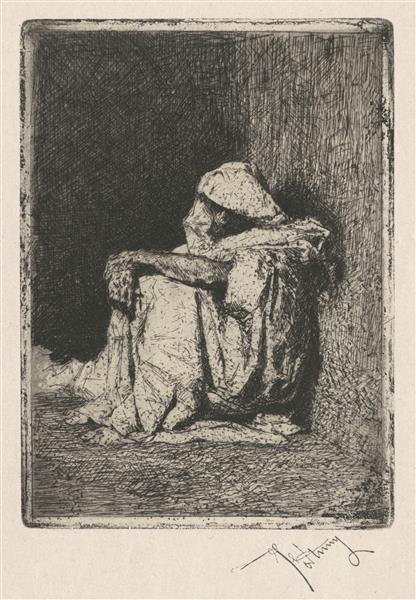Description
The "Sitting" (original title in English: "Seated Arab"), made by Mariano Fortuny in 1873, is erected as a representative work of exotism and romantic interest to the Arab world that characterized the art of the nineteenth century. Fortuny, one of the most prominent Spanish painters of his time, immersed himself in a style that combines the academic precision with the vivacity of impressionism, offering a unique perspective in each of his works.
In "Sitting Arab", the central figure of an Arab man, with his traditional clothing, is portrayed masterfully. The character's relaxed possession, sitting with one arm supported on a structure that reminds of an oriental furniture, reveals not only the technical domain that Fortuny possessed about the representation of the human figure, but also a deep empathy towards the subject that portrays. The artist manages to convey a feeling of serenity and contemplation, raising the figure of Arabic to an almost poetic level. Attention to detail is remarkable; Each fold of his clothing, the turban that adorns his head and the serene expression on his face are painted with an amazing precision, inviting the viewer to an almost intimate experience with the model.
The color palette used in this work is another aspect that deserves to be highlighted. From a base that mixes warm and terrible tones, Fortuny manages to create a chromatic balance that surrounds the figure in an aura of authenticity. The nuances of the textiles that dress the Arabic represent an exercise of observation and sensitivity that allows not only the richness of the portrayed culture, but also the artist's ability to play with light and the shadow, creating volume and depth. This color attention translates into an environment that seems almost enveloping, causing the viewer to feel connected not only to the work, but with the world it represents.
Fortuny, who had moved to Morocco and other regions of North Africa, was influenced by his surroundings, and this painting is a clear evidence of that fascination with exotism. Through his work, Fortuny not only captures an image, but also evokes the cultural wealth of an era and a place, full of nuances and meanings. The influence of orientalist painting becomes evident, but Fortuny adds its peculiar approach, moving away from a mere visual representation to offer a deeper interpretation that invites contemplation and reflection.
The year 1873 marks a crucial moment in Fortuny's career, since at this time he is in the apogee of his mature style. "Sitting Arab" reminds us of the author's ability to transcend the limits of simple representation. The work stands out not only for its technical quality, but also for the narrative it suggests, imbueting in the viewer a sense of curiosity and admiration for the subject portrayed.
In conclusion, "Arab sitting" is not only an oil that reflects the mastery of Mariano Fortuny, but also a testimony of the intercultural dialogue that occurred in the painting of the nineteenth century. In this painting, The fusion of technique, color and narrative content allows the viewer to enter a different world, full of history and meaning, which reaffirms Fortuny's legacy as a pioneer of art that knew how to capture the essence of the other in his work.
KUADROS ©, a famous paint on your wall.
Hand-made oil painting reproductions, with the quality of professional artists and the distinctive seal of KUADROS ©.
Art reproduction service with satisfaction guarantee. If you are not completely satisfied with the replica of your painting, we refund your money 100%.

